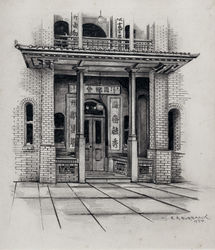
19th, 20th & 21st Century Fine Prints
707-546-7352 · fax 707-546-7924 · web: www.annexgalleries.com · email: artannex@aol.com
Elbridge Ayer Burbank Biography
Elbridge Ayer Burbank
American
1858–1949
Biography
 Born in Harvard, Illinois, Elbridge Ayer (E.A.) Burbank graduated from the Chicago Art Academy and then, working from a studio in St. Paul, Minnesota, painted scenery for Northwest Magazine to inspire homesteading along the railway line of the Northern Pacific. This job took him West to the Rocky Mountains, Idaho, Washington, and Montana.
Born in Harvard, Illinois, Elbridge Ayer (E.A.) Burbank graduated from the Chicago Art Academy and then, working from a studio in St. Paul, Minnesota, painted scenery for Northwest Magazine to inspire homesteading along the railway line of the Northern Pacific. This job took him West to the Rocky Mountains, Idaho, Washington, and Montana.
In 1887 and 1889 to 1891, he studied art in Munich, Germany, and there became friends with artists Joseph Henry Sharp, William R. Leigh and Toby Rosenthal. Following this, he briefly had a portrait studio in London, England, and then he returned to Chicago where in 1892, he had his first exhibition at his studio that he had just opened. Among the works were portraits including Portrait of a Woman, Munich, 1892 that was positively reviewed by a writer for the Chicago Tribune. Because the work was formal and characteristic of society portraiture of that era. it is suggested that Burbank was trying to attract portrait commissions. The sitter was likely the artist's wife, Alice Blanche Wheeler.
In 1894, Burbank became an American citizen, and graduated from the Chicago Art Institute where he was invited to stay and teach. He spent many summers painting in Giverny, France, the home of Impressionist Claude Monet. Burbank's Giverny paintings were typical Giverny subjects of women in outdoor landscape.
In 1898, he experienced a great turning point in his life as a result of a special commission from his uncle, Edward Ayer, who was first president of the Field Columbian Museum and owner of one of the most complete libraries on Indian culture. Ayer hired his nephew to do portraits of Indians prominent in that time.
On this assignment, Burbank traveled west again, and in Ganado, Arizona, met trading post owner Lorenzo Hubbell who became a life-long friend. During his western trips, he painted over 2000 portraits of Indians from 125 tribes: 1000 were oil portraits and 1200 were with Conte Crayon. He was one of the few artists to use crayon as a medium for portraits.
He was the only artist to paint Geronimo from life, and he also painted Red Cloud and Chief Joseph. The collection of paintings from these western travels in is the Newberry Library in Chicago, and another large group of his paintings is at the Smithsonian in Washington D.C.
From 1900, he traveled constantly in the West and divided his time between California, Arizona, Oklahoma and New Mexico. He spent much time at the Hubbell Trading Post, writing in a letter: "Whenever I am away from Ganado, I always fell I am away from home. I am happiest there than any place I have yet been to." (Portraits of the People) It is thought that it was his influence that stirred Hubbell's interest in art, which in turn, led to him forming an art collection that remains at the Trading Post in the Hubbell private home. Work by Burbank comprises about one-third of the collection. He also painted numerous Navajo rug designs for Hubbell, who then used them as samples for commissioning rugs to sell.
For the last eighteen years of his life, he was in mental hospitals, treated for manic depression, and towards the end of his life, lived in the basement of the Manx Hotel in downtown San Francisco where he had moved in 1917.
He died on March 21, 1949 at age 97 from injuries from being hit with a cable car several months earlier.
Compiled by Lonnie Pierson Dunbier
